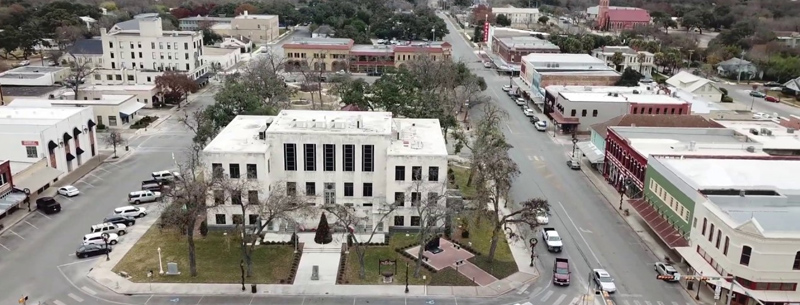Seguin, TX is one of the oldest, most historic towns you’ll ever step foot in. Outside of their great history, Seguin offers up a central location, one that makes for an easy drive to Austin, San Antonio, Houston or Corpus Christi.
If the history and convenience of Seguin don’t interest you, the cost savings and fun activities will – Seguin offers something for everyone. You can play in the water, eat fine foods, drink great drinks, golf till your arms fall off and best of all, just enjoy the small-town Texas charm.
Small enough to have a friendly feeling, Seguin is a town where the tree-lined streets are graced by Queen Anne homes and comfortable bungalows. This is a community where families live in neighborhoods among people of all ages, incomes, and backgrounds, where good schools are a proud tradition, and where a fine park stretches along the beautiful Guadalupe River.
Starcke Park
Seated on the Guadalupe River and surrounded by beautiful elm, pecan and cypress trees, Starcke Park offers it all. You will find a golf course, wave pool, basketball courts, pavilions, barbecue pits, walking trails, and just the ultimate relaxation.
The Oak
Properly named for the area, The Oak has been and is the best bar around. For ages, locals and tourists have been enjoying cold beers inside this historic bar. The Oak offers up a wide selection of bottles and beer on tap. Outside of great beer, you can play pool, shoot darts, play cards or catch a sporting event on one of the many flat-screen televisions.
The Worlds Largest Pecan
Found in the historic downtown area of Seguin, TX, the pecan is a must-see. It has a lot of great history, and it is also made for a great photo op. Anytime you can see record-breaking history, you can’t pass it up.
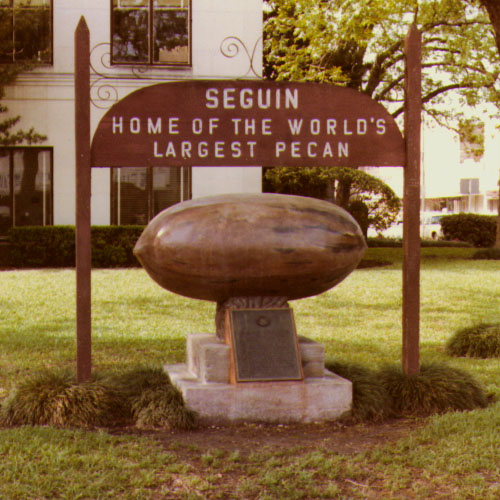
The world’s largest pecan (1,000 LBS.!) was placed near the courthouse in 1962 as a symbol of the nut’s importance to the region. The first written record of the pecan entered into the journal of Pope de Oviedo in 1553, placed the discovery of the pecan in the Guadalupe River Valley near present-day Seguin. About 3,000 acres of managed orchards are under cultivation in Guadalupe County.
Historic Seguin Sites
Welcome to Seguin, a historic frontier town founded in 1838 during the days of the Republic of Texas. Most of Seguin’s secrets are told and much of its history comes to life in the book, TRUE WOMEN (1994), by native Janice Woods Windle. What began as a family history was given to a son and his bride turned into a collection of great epic tales of war and adventure, love and murder, violence, and redemption. Relive Seguin’s history… relive the tales of True Women… Welcome to Seguin!
King Cemetery
Where better to start your tour than viewing the final resting place of Euphemia Texas Ashby King? You will find the King Cemetery just west of King Street on Gonzales Street. The main character in the book’s first section, Euphemia lived the pioneer days–taking part in the Runaway Scrape ahead of Santa Anna’s Mexican Army and coming face to face with Comanche warriors.
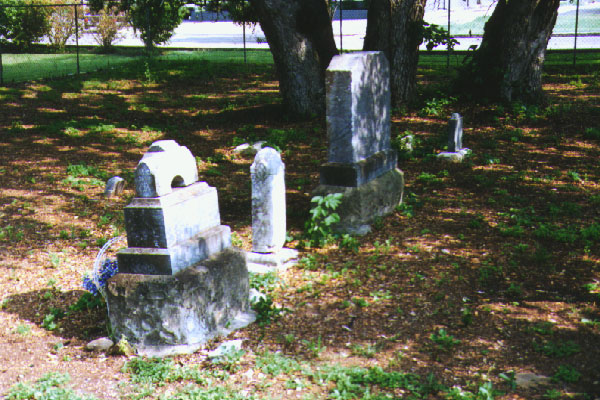
Euphemia’s funeral detailed on page 384: “Slowly, quietly, the women both black and white, moved down the hill…Euphemia had been a pioneer and a warrior. She had hurled herself against the times and had changed the lives around her. Her life was heroic.” Buried alongside the matriarch of the author’s maternal family tree are four Texas Rangers and Granny Boyd, Seguin’s first Sunday School teacher.
Bettie Moss King Home and Barn
From the King Cemetery, continue west on Gonzales Street until it dead-ends at a church parking lot. Continue through the parking lot until you come to the back of the Bettie Moss King home and barn. Pause here and imagine yourself on this spot 50 or 100 years ago. No paved roads or urban sprawl–an agricultural haven with fields of cotton and native pecan and walnut tree and a barn three times larger than the present. The author’s childhood home is still inhabited by her mother, Virginia Woods.

The King land stretched from King Branch to Capote Road east of town and from the river to the railroad tracks on Seguin’s northeast side. The present home is a one-story neoclassical house built in 1887 by Henry A. King, Euphemia and William’s son. The furnishings include a trundle bed which belonged to Euphemia, and Henry and Bettie Moss King’s dining room set. When you leave the parking lot, head west to the end of the block, where you will face Euphemia’s “new home.” The original tiny two-room log cabin that Euphemia and William King built here above the springs of King Branch was dismantled in 1936 and placed on exhibit for the Texas Ranger Centennial exhibit in Ft. Worth.
Capote Bridge
Go east on Court Street, passing in front of the Bettie King home as you head to King Street. At King Street, take a right and head south through the country as King turns into FM466, also known as Capote Road. Find a place near where Capote Road crosses the Guadalupe to pause and reflect.
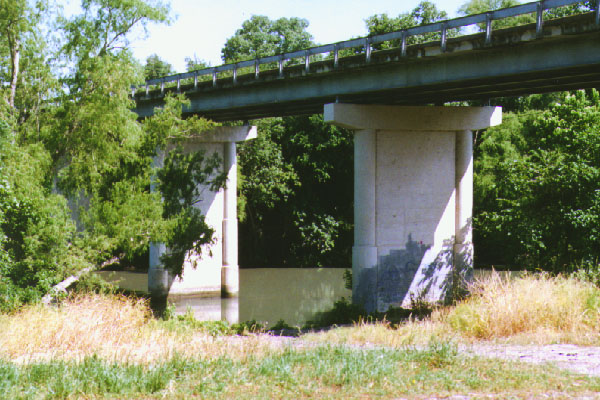
“Each year on Independence Day, the Farmer’s Alliance hosted a public celebration in the wooded park where the Capote Road bridge crossed the Guadalupe River…in 1922 the issue on everyone’s mind and lips was Congressman Harry Wurzbach, the first Republican congressman since Reconstruction to represent Guadalupe County and the only Texan in Congress to vote for a law that made lynching a criminal offense.”
Capote Road crosses the river on the site of the old Sheffield Cattle Crossing used by several trail drives on their way from South Texas to northern railheads.
Hollamon Oaks
Return past the Bettie King home on Court Street. Continue west on Court and turn south on San Marcos Street which takes you to the entrance of Glen Cove Estates and the Holloman house, which dates back to the mid-1800s. “Sam Houston came to Seguin in July of 1857 to campaign for Governor of Texas. Euphemia walked to the Hollamon home on its hill above the Guadalupe. Houston made an impassioned speech beneath the oaks and elms of that great estate.”
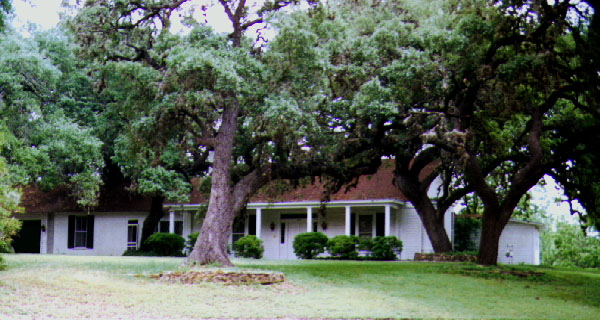
Pink Rosebud House Site
As you leave Glen Cove and travel west on Nolte Street towards downtown, pause to view the area which was once the home of Pink Rosebud. The town madam (p. 393) who said “whatever you may think of me, do know that I love this town,” resided in what is now a barren field to the east of Milam Street between Center and Nolte Streets.
Magnolia Hotel
Across Milam Street from Pink Rosebud’s house site sits the Magnolia Hotel built-in 1842. Along with Sebastopol, it is one of the first structures to use concrete. The original two rooms were constructed with logs intended for a blockhouse on the public square, but not needed, as the danger of Indian attacks had been reduced.
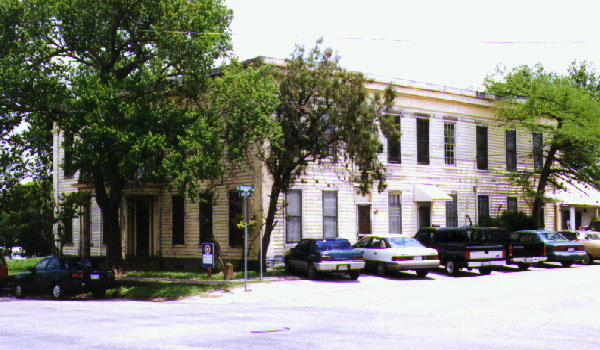
Another item of interest is the stone step at the corner of Crockett and Center streets used by slave boys to ring a bell brought to Seguin from the Alamo. The bell was rung to welcome stagecoaches or announce the news. The Magnolia Hotel (p. 336) was where Bettie saw Pink Rosebud “stepping from a carriage…her dinner gown a sensation, her two uniformed footmen carrying the long, long train. Never had there been a woman more mysterious.”
Seguin’s Frontier Heritage
Continue west on Nolte Street and turn left on River Street. Two blocks south on your left are several properties operated by the Seguin Conservation Society.
Los Nogales Museum
Los Nogales (Spanish for walnuts), was built in 1849 of adobe construction similar to that made by Mexican Indians. The adobes were no doubt made from dirt dug to form the cellar. It was an early pioneer home used after the Civil War by members of the Freedmen’s Bureau and serves today as a museum.
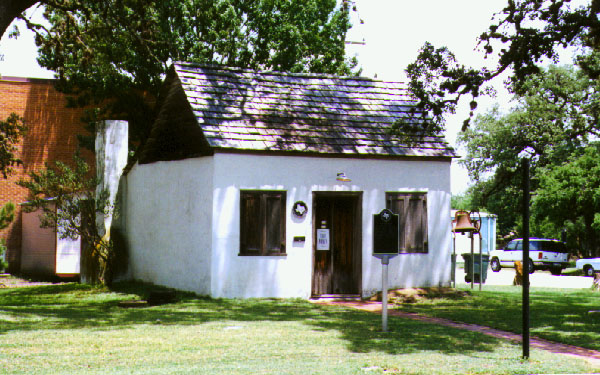
Campbell Log Cabin
The cabin dates back before 1850 when it was built eight miles southwest of Seguin. It was moved to its present site in 1979. The home features a dog run popular in early construction for cooling and use for general family life.
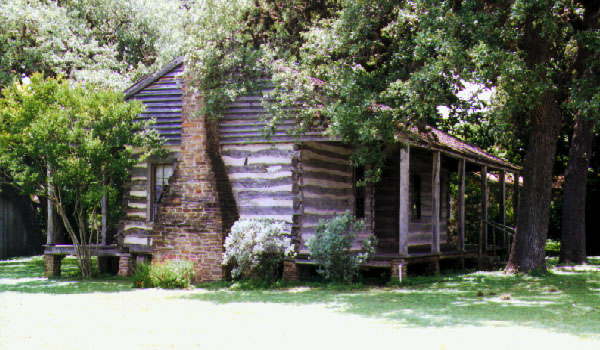
First Methodist Church
To the back of the log cabin is the church originally located at the Courthouse square where the “True Women” gave their egg money to fund the structure. “Fleas from the town’s running pigs infested the sanctuary (p. 129).” Later, (p. 130) “Euphemia Texas Ashby and William King were married in the newly disinfected Methodist Church.”
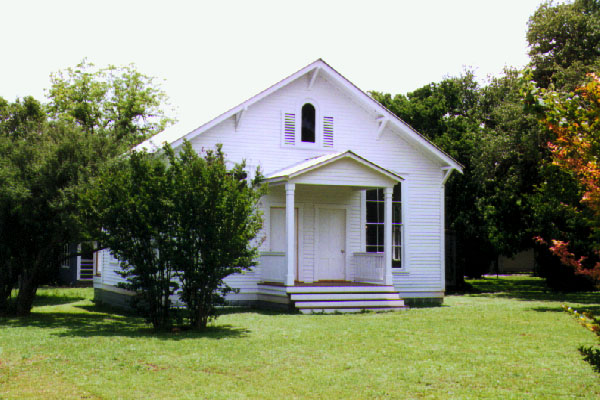
Riverside Cemetery
Continue south on River Street until you come to Riverside Cemetery, the final resting place of many of Seguin’s early settlers and Confederate heroes. It was also the home of “Peachtree,” (p. 11) a “raggedy old man who lived in the river bottoms not far from Idella’s house. He was a hermit with long, unkempt hair and terrible secrets.” The south side of the cemetery, facing the river, is marked with a limecrete stone wall, erected in the mid 19th century as one of the town’s pioneer defenses.
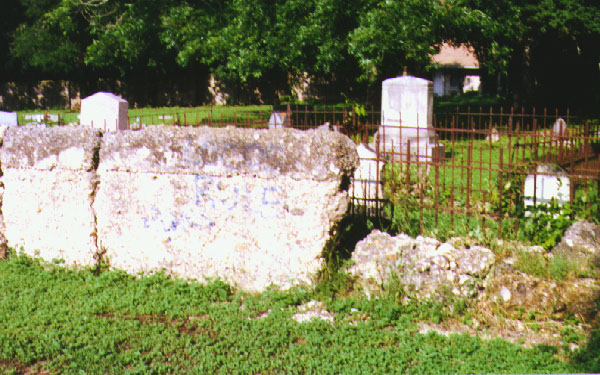
Juan Seguin Gravesite
From the cemetery, turn south on Austin Street, then west on Nelda Street, and north on Saunders Avenue. At the top of the hill is the Juan Seguin gravesite. A marker chronicles his life and contributions to Seguin and all of Texas.
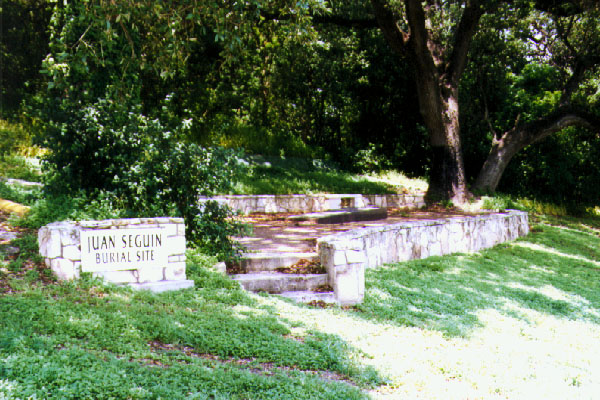
The Male Academy
Return to Austin Street and proceed north to downtown. On your left at Convent Street is the Male Academy where Euphemia and William’s sons, otherwise known as “the rowdy King boys,” attended school. A two-story building dedicated in 1850 and purchased in 1929 by the St. James Parish, the building now houses St. James school. It is the oldest schoolhouse still in use in the state.

Courthouse Square
The Courthouse Square was the center of all activity in the growing community. Pause to take in several historical places and buildings.
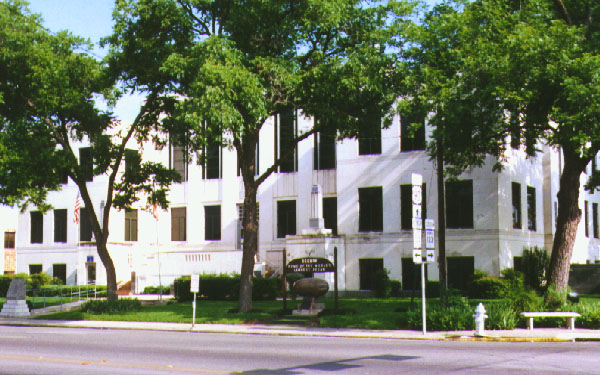
In the years after the Civil War, the True Women of Seguin helped bring about the Fusion Convention on the Courthouse Square. “Soon the leaders of Seguin (p. 163), with their vastly different political beliefs, announced… an alliance between Conservative Republicans and Liberal Democrats that sought to hammer out a legitimate political order in Texas.”
Plaza Hotel
On the corner of River and Nolte streets sits the Plaza Hotel, built-in 1916. Across Nolte Street was the area used by the Army of Occupation after the Civil War. “Since the Yankee encampment (p. 156) was so near her house, Euphemia feared for the safety of her children (the rowdy King boys) who had to walk past the soldiers to get to school.
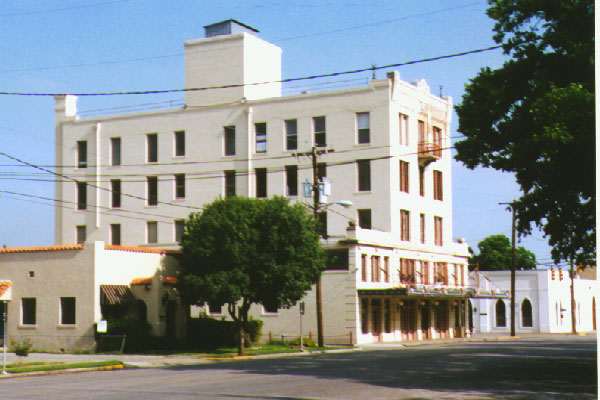
Frontier Justice
Several trees on the courthouse square were used to help administer punishment to early criminals. The Whipping Tree located between the fountain and the Courthouse still has a steel ring imbedded in the trunk. The ring was used for tying any person found guilty of a crime punishable by lashes. It probably had more publicity than use. The Hanging Tree was located in the street at the corner of the Plaza Hotel. The tree was removed in 1984.
Old Spanish Trail
Directly in front of the Courthouse is a marker recognizing the Old Spanish Trail used by early explorers such as Cabeza de Vaca. One of their observations was the Rio de las Nueces (River of Nuts) which they first called the Guadalupe River because of its pecan and walnut lined banks.
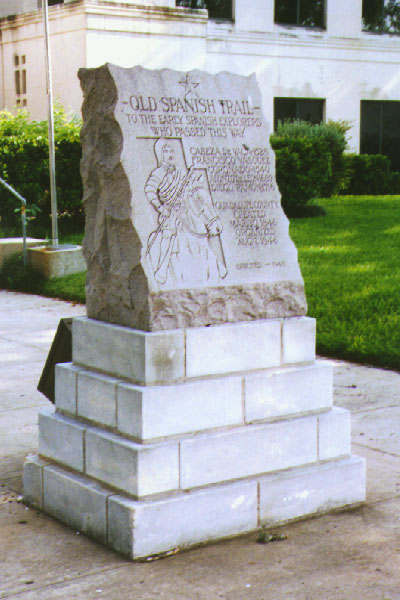
Downtown Architecture
Of the many buildings of interest on the Courthouse square are the Vivroux building to the west of the courthouse which is still known for its creaking hardwood floors; the Tips building at the Southwest corner of Austin and Court streets built in 1890, home of Seguin’s first Opera House where the first movie was shown in 1899; a few doors north of the Courthouse was the Scott Boarding House (p. 368) “a fine boarding house on Austin Street…popular among drummers and traveling businessmen who stopped in Seguin for lodging and for the legendary meals served at their table”; and Belie Fulghrum’s dress shop, located behind the present Farm Bureau building at Center and River streets was where Bettie Moss King “was fitted for her wedding dress.”
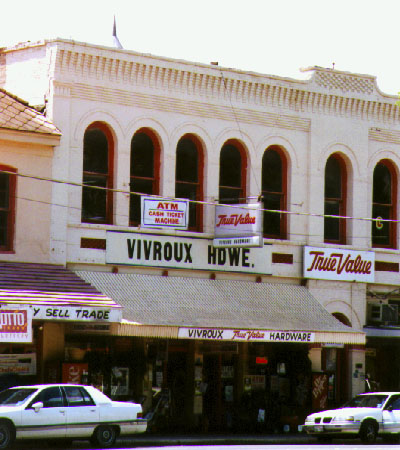
The Female Academy
From the courthouse, turn west on Court Street for three blocks, then north on Bowie Street. Here you find Saegert Middle School, formerly Seguin High School when Janice was a Freshman. The Female Academy and Guadalupe College were also earlier on this site.
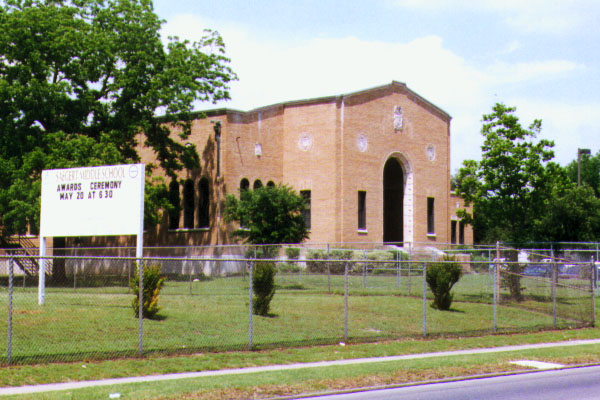
Euphemia’s teacher from Rutersville, Annie Franklin, came to Seguin to teach at the Female Academy. Annie had a tremendous influence on Euphemia’s philosophies. From Annie, Euphemia first heard a woman challenge the right of men to preside over human society.
Women’s Federated Building
From the Female Academy, turn east on Mountain Street and pass by the old central fire station restored as part of the Seguin State Bank & Trust, then north on Austin Street. Behind the Seguin-Guadalupe County Chamber of Commerce building on Austin Street is the Women’s Federated Building facing River Street. On Saturday visits to the Courthouse, Square women would stop here to change their babies’ diapers.

The building was part of “Bettie Moss King’s dreams of becoming a young woman of leisure…of helping organize the Seguin Village Improvement Society.” While in the vicinity, note the Texas Theater next door to the Chamber office. Built in 1931, and still in occasional use, the theater’s landmark marquee has been the focal point of several national product commercials.
